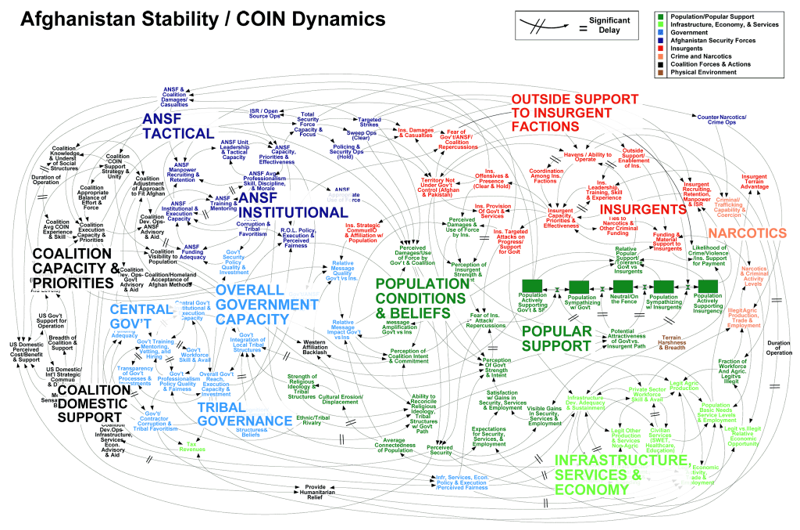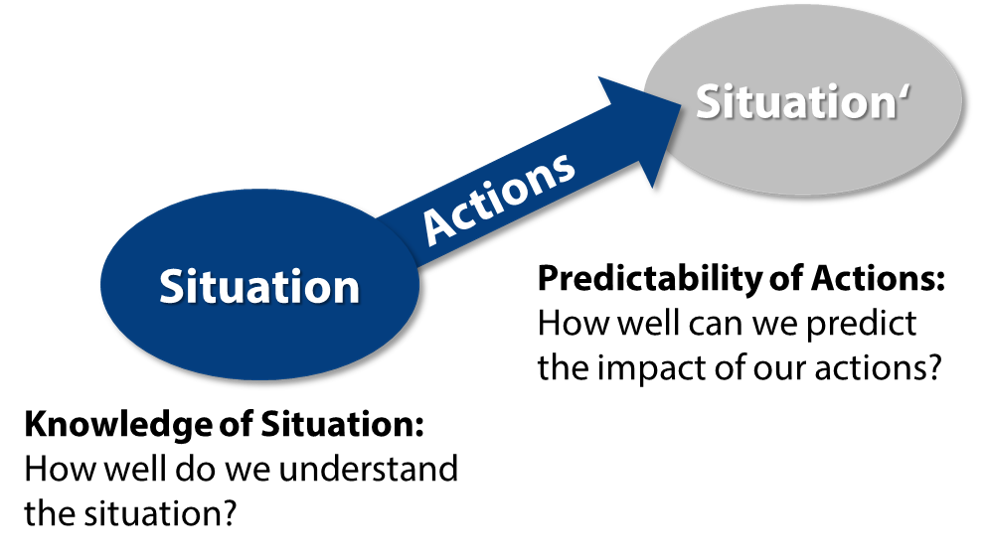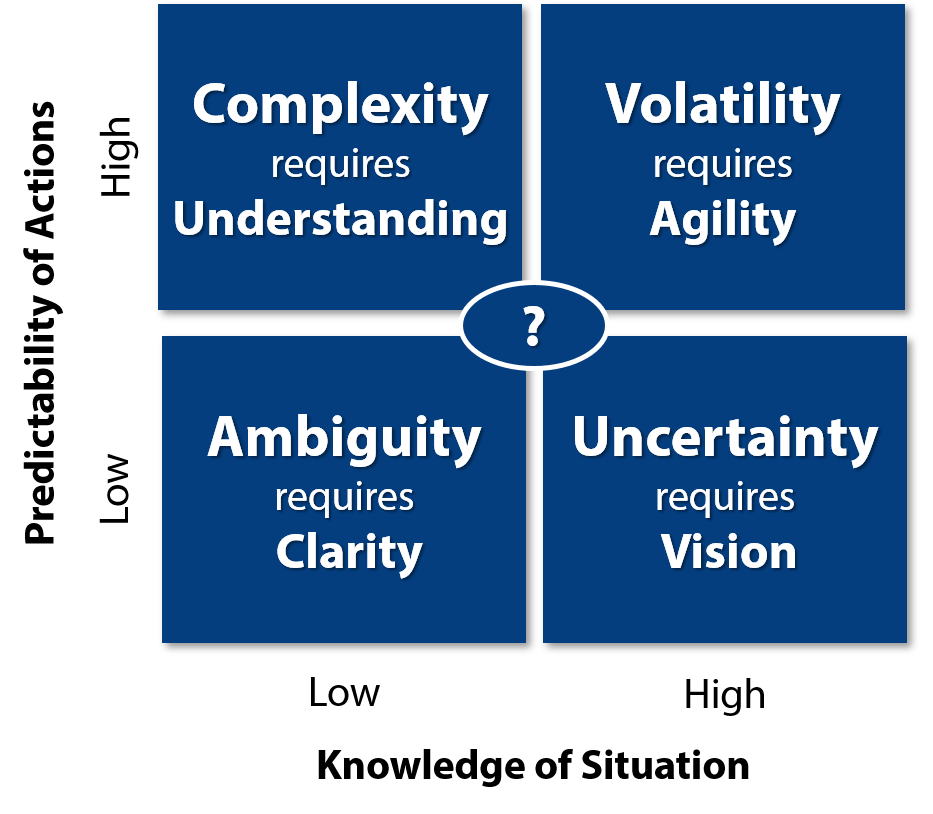VUCA stands for Volatility, Uncertainty, Complexity and Ambiguity. But it is more than a four letter acronym (FLA). It is a leadership framework.
If you are interested in VUCA leadership, why and how VUCA can help you lead successfully in a world of chaos, and what the role of agility is, read on.
The Origins of VUCA
VUCA is a leadership framework created by the U.S. Army War College at the beginning of the 1990ties to develop a new kind of leadership.
During the conflicts after WWII the U.S. army found itself increasingly in situations that were lacking the classic battle field setup. No more “We are here, the enemy over there… let’s decide how to position ourselves to win this”.
Instead, it was about jungle warfare and guerrilla attacks. You moved into a new village and didn’t know who friend or foe were. Would the civilians greet us with food or fire? This could change from village to village. The Vietcong could be everywhere. No situation was identical.
Geo-political and other factors contributing to this include the collapse of the Soviet Union, globalization, information technology, economic and political instability and climate change.
More and more the troops found themselves in situations where they needed to react quickly with no time to call for guidance. “Aehm, Captain Jones here, Sir, we are under attack. Yes, …no…, no…. let explain what is going on. Oh, you have to go to a meeting now? Ok, let me call back later… (if we are still alive)”
The fighting units needed to make decisions themselves. They needed a drastically new way of working. Work as self-contained teams that move and react quickly and make the right decisions even in isolation. They needed to be more agile.
In 2010 the US analysed the situation in Afghanistan and documented their findings about the complexity of the situation with this picture:

Situation Analysis Afghanistan 2010
A general who attended the presentation remarked: “When we understand that slide, we’ll have won the war.” 10 years later, Afghanistan is still a war-torn country.
The reaction of the media and public was devastating. The picture was ridiculed, PowerPoint was blamed. It was shocking. The general public was at utter denial of reality. Longing for simple solutions that simply do not exist in situations of complex interconnections and interdependence.
Face reality as it is, not as it was, or as you wish it were. Be candid with everyone. Don’t manage, lead. Change before you have to.
Jack Welch
Or if you like a more lyrical version:
It does not do to leave a Dragon out of your calculations, if you live near him.
J. R. R. Tolkien
The U.S. Army recognized this new level of interconnection and interdependence early and saw the urgency to act. So the U.S. Army War College started to work on VUCA in the beginning of the 1990ies supporting operations for example in Iraq with rules of engagement that also protect the life of civilians.
Over time, business leaders started to encounter more and more VUCA situations. It started to become known in the business world. Understanding VUCA provides important insights into situations also businesses can find themselves in. It also provides guidance about how to respond.
VUCA explained
To understand a situation, VUCA asks two questions:

- How well do we understand the situation?
- How well can we predict the impact of of our actions?
In our global and interconnected world with highly individualized consumers and fierce competition chances but also risks are abundant. Our business environments are highly dynamic with new players entering markets, industry boundaries dissolving, and new ecosystems forming constantly. Understanding the situation fully is increasingly difficult as is knowing which actions will have the greatest impact today as well as be sustainable in the future.
VUCA then uses the two dimensions to create a 2×2 Matrix with each of the four VUCA elements describing a situation with a different combination of the answers to the two questions.

The simplest situation is Volatility where we can understand the situation as well as predict the outcome of our actions but things are moving so fast that we cannot keep up.
Complexity describes a situation where the current situation is challenging. There are too many parts that are connected in dynamic way with each other and influence each other creating vicious and virtuous cycles.
Under Uncertainty the future is hazy. The first bird gets the worm but the second mouse gets the cheese. So what is the better approach?
Pure situations of uncertainty are rare. Often uncertainty also results from complexity. Because we don’t understand the current system, we also won’t know how to ‘fix’ it. Take our financial system, for example.
The worst situation is ambiguity where both dimensions are unknown.
A complication arises from the fact that it is not always clear which VUCA element is currently at play. This carries the risk of taking wrong actions with potentially adverse effects.
The following table describes each element in more detail and also lists risks to avoid in order to manage successfully.
| VUCA Element | Description | Example | Risks |
| Volatility Situation: high Actions: high | Rapid and unexpected changes with unclear duration but not necessarily hard to understand. We struggle to keep up. | Thai flooding that took hard disk suppliers offline, shattered supply chains and caused a year long price spike | Outdated information, too slow responses, risk-aversion |
| Uncertainty Situation: high Actions: low | Not knowing what will happen and what the future will hold. Surprises are possible. | Apple Pay creates uncertainty for banks | Incomplete information, resort to what worked in the past |
| Complexity Situation: low Actions: high | Too many moving and connected parts with unclear causes, effects and interactions with an overwhelming amount of information. | Global financial crisis created snow ball effects due to the inter-connectedness of the global banking system | Analysis Paralysis, address symptoms, resort to short-term fixes and quick-wins |
| Ambiguity Situation: low Actions: low | Multitude of different perspectives and viewpoints, cause-and-effect confusion, inability to correctly interpret events & situations. No precedents and „unknown unknowns“. | The impact of the Internet of Things and the impacts of e.g. security flaws, direct M2M communication and data privacy. | Failure to understand the significance of events, not taking appropriate actions, mis-interpretation |
Note that VUCA does not leave room for a normal situation. With both dimensions ‘high’ it should be “all good!”. But VUCA still assumes Volatility. This makes Volatility the “new normal” in a VUCA world.
The all-too-common and omni-present fear of disruption that is constantly asking the nagging question: “Are we missing something?” is becoming a permanent elephant in the board room.
VUCA Management

Each VUCA element has a default recommended action jointly sometimes described as “VUCA Prime” or VUCA’: Vision, Understanding, Clarity and Agility. Your address VUCA with VUCA’.
Agility is the recommended action for the simplest situation of Volatility. We can understand what is going on and what will be happening. We just do not have the time to analyse it. Things are simply moving so fast that we can often only react. This requires agility. On a personal as well as organizational level. In the context of business agility and inline with the U.S. Army learnings small teams that work with individual customers in a smaller market settings (situations) are an efficient way to implement this.
Even in the other situations there will always be an element of volatility. So agility is good to have in general.
The recommended actions for the other three situations include:
- working harder to understand the reality of a complex situation e.g. with systems thinking
- providing guidance in the form of vision in times of uncertainty e.g. with foresight
- creating clarity in times of ambiguity e.g. with personality
Especially the last two require visionary and bold leadership. Leaders often ask me how they can gain the certainty that their vision or clarity is correct. As a futurist I would like to provide this certainty. But I also realize that it does not exist. There is no red pill.
You will have to lead the way without knowing yourself based on the confidence in yourself, your team, and partners. Being only certain about that you will find a way. The futures cannot be predicted, but it can be shaped.
So give me a turbulent world as opposed to a quiet world and I’ll take the turbulent one.
Andy Grove
Going deeper into leadership is beyond the scope of this article but it shows that good leadership, that is inspiring, servant, and instills a growth mindset is as critical to the success of an organization in a VUCA world as is agility.
To close with the beginning, here are some VUCA Solution Competencies taught by the Strategic Leadership Program of the U.S. Army War College:
Conceptual Skills:
- Powerful frame-of-references & mental models
- Foresight
- Agile Problem Management
Technical Skills:
- Systems Understanding
- Networking/Relationships
- Political/Social Competence
Interpersonal Skills:
- Consensus Building
- Negotiation
- Communication
If you want to know more, we offer a training about “VUCA – Managing in a world of chaos.”
